USST_Arts_112480756 我国城镇化与能源消费结构间关系的研
VIP免费
摘 要
2012 年,中国城镇化率达到 52.57%,接近世界平均水平,城镇化建设取得
了瞩目的成就。与欧美发达国家相比虽然中国城镇化率并不高,但我们在能源消
费总量、二氧化碳以及固体颗粒排放量等污染物数据方面却长期“名列前茅”。
随着近来雾霾天气的频繁发生,人们逐渐开始关注空气质量和大气污染。由于化
石能源的燃烧是造成大气污染的主要成因,越来越多的学者开始把研究目标集中
在我国的能源消费结构上,在城镇化趋势不可逆转的形势下,如何有效提高能源
效率、协调城镇化与能源消费结构二者之间关系的探讨将逐渐成为未来研究的热
点。鉴于以上原因,本文将以我国城镇化与能源消费结构之间的相互作用作为研
究对象,以揭示城镇化与能源消费结构的关系为研究目的,在理清中国城镇化与
能源消费结构现状的基础上,选取 1992-2011 年全国城镇化与能源消费的相关数
据,在计量经济理论基础上建立城镇化与能源消费结构间关系的响应机制模型。
采用动态计量分析的方法,验证城镇化与能源消费结构的响应机制,揭示城镇化
与能源消费结构的内在规律和发展趋势。
本文从人口、社会、经济、环境四个角度构建了综合城镇化指标,采用熵值
法计算各个指标的权重,将各指标标准化后的数值与其对应的权重相乘得到综合
城镇化指数。研究结果显示:(1)从消费总量上来看,人口城镇化指标较综合城
镇化指标对能源消费的促进作用较大,与此同时二者的发展除了受自身波动的影
响之外,还受到能源消费总量的影响。(2)从消费结构来看,煤炭、石油等化石
能源对我国城镇化的发展起重要作用,这其中尤以煤炭的作用最大。(3)与欧美
发达国家相比我国能源消费结构仍有许多可以改进的地方,在未来发展中应当稳
步发展水利以及核能,大力拓展可再生能源的使用,充分发挥其替代作用。
综合论文的研究成果,本文对中国新型城镇化发展提出了走可持续发展的城
镇化道路、改善民生增加社会福祉、提高能源利用效率、大力发展可再生能源等
建议。
关键词:能源消费结构 综合城镇化指数 计量经济理论 动态计量分
析 熵值法
ABSTRACT
In 2012, the urbanization rate of China came to 52.57%, and reached the world
average level, the urbanization construction has made significant achievements.
Compared with Euro-American developed countries, although China's urbanization
rate is not high, but we always stay “top-ranking” in these indexes such as total
energy consumption, Carbon dioxide emissions, pollutant of solid particle emissions
and so on. As the fog haze weather occurred frequently these days, people began to
focus on air quality and air pollution gradually. Due to the burning of fossil fuel is the
main cause of air pollution, more and more scholars begin to focus their research on
the energy consumption structure in our country, Under the irreversible trend of
urbanization procedure, the discussion of how to improve the energy efficiency,
coordinate the relationship between urbanization and the energy consumption
structure will gradually become a research hotspot in the future. In view of these
reasons above, this article will make the interaction between urbanization and energy
consumption structure in our country as the research object, reveal the relationship
between urbanization and energy consumption structure as research purposes, basing
on clarification of the present situation between Chinese urbanization and energy
consumption structure, select the data of national urbanization and energy
consumption from 1992 to 2011, and finally establish a mechanism response model
of the relationship between urbanization and energy consumption structure based on
the econometric theory. Adopt the dynamic econometric analysis method to validate
the response mechanism of urbanization and energy consumption structure, reveal the
inherent law and the development trend between urbanization and energy
consumption structure.
In this paper, we construct a comprehensive urbanization index from four aspects
of population, society, economy and environment, using entropy method to calculate
the weight of each index, and get the comprehensive index of urbanization through
multiplying the standardized values by the weight of each index. The results showed
that: From the view of total energy consumption, compared with comprehensive
urbanization index, population urbanization index has bigger promoting effect on the
energy consumption, at the same time the development of both indexes were affected
not only by the fluctuation of themselves, but also the total energy consumption; From
the point of consumption structure, coal, petroleum and other fossil energy plays an
important role on the development of urbanization in our country, and the affection of
coal is the largest; Compared with Euro-American developed countries, China’s
energy consumption structure still has a lot of room for improvement, we should
develop water conservancy and nuclear power steadily, expand the use of renewable
energy vigorously, make full use of its replacement in the future.
Finally, according to the results above, this paper propose several suggestions to
the development of China's new pattern of urbanization: insist on sustainable
development of urbanization, improve people's livelihood, increase social welfare,
improve energy efficiency and develop renewable energy vigorously.
Key word: energy consumption structure, comprehensive
urbanization index, ecosystem, econometric theory, dynamic
econometric analysis, entropy method
目 录
中文摘要
ABSTRACT
第一章 绪 论........................................................ 1
1.1 研究背景及意义 .................................................................................................. 1
1.1.1 研究背景 ....................................................................................................... 1
1.1.2 研究意义 ....................................................................................................... 6
1.2 研究问题及内容 .................................................................................................. 6
1.2.1 研究的问题 ................................................................................................... 6
1.2.2 研究的内容 ................................................................................................... 7
1.3 研究方法与技术路线 .......................................................................................... 8
1.3.1 研究方法 ....................................................................................................... 8
1.3.2 技术路线 ....................................................................................................... 8
第二章 城镇化与能源消费结构的文献综述.............................. 11
2.1 城镇化的理论基础与相关研究 ........................................................................ 11
2.1.1 城镇化的理论基础 .................................................................................... 11
2.1.2 城镇化的相关研究 .................................................................................... 12
2.2 能源消费结构的理论基础与相关研究 ........................................................... 13
2.2.1 能源消费结构的理论基础 ........................................................................ 13
2.2.2 能源消费结构的相关研究 ......................................................................... 14
2.3 我国城镇化与能源消费结构的研究 ............................................................... 15
2.3.1 研究内容 .................................................................................................... 15
2.3.2 研究指标 ..................................................................................................... 17
2.3.3 研究方法 ..................................................................................................... 17
2.4 文献总结 ............................................................................................................ 18
第三章 理论假设与研究方法.......................................... 20
3.1 变量选择 ........................................................................................................... 20
3.2 研究方法 ............................................................................................................ 22
3.3 研究假设 ............................................................................................................ 25
第四章 我国城镇化与能源消费结构关系的实证分析...................... 26
4.1 数据来源 ........................................................................................................... 26
4.2 我国城镇化与能源消费结构的动态效应分析 ............................................... 26
4.2.1 协整检验 ..................................................................................................... 29
4.2.2VAR 模型稳定性检验 ................................................................................. 30
4.2.3 脉冲响应函数 ............................................................................................. 32
4.2.4 方差分解 ..................................................................................................... 34
4.3 城镇化与能源消费结构的动态响应分析 ........................................................ 36
4.3.1 协整检验 ..................................................................................................... 37
4.3.2 VAR 模型稳定性检验 ................................................................................ 39
4.3.3 脉冲响应函数 ............................................................................................. 42
4.3.4 方差分解 ..................................................................................................... 45
4.4 欧美发达国家城镇化发展与能源消费结构的研究 ........................................ 46
4.4.1 美、英、法、德四国的(人口)城镇化水平 ......................................... 47
4.4.2 美、英、法、德四国能源消费结构 ......................................................... 47
第五章结论与展望................................................... 51
5.1 主要研究结论与对策建议 ................................................................................ 51
5.1.1 主要研究结论 ............................................................................................. 51
5.1.2 对策与建议 ................................................................................................. 52
5.2 研究局限与展望 ................................................................................................ 54
参考文献........................................................... 55
致 谢.............................................................. 60
附录:............................................................. 61
第一章 绪论
1
第一章 绪 论
1.1 研究背景及意义
1.1.1 研究背景
城镇化是一个极其复杂的过程,它不仅涉及社会、人口、地域空间还关联到
经济、环境等诸多方面,是一个国家工业化、现代化的重要标志,也是人类社会
发展的必经之路[1]。人口学对城镇化的定义是:农村人口向城镇人口转变的过程。
他们所说的城镇化就是最直接的人口的城镇化,指的是“人口向城市地区集中,
或农业人口向非农业人口转变的过程”。从社会学的角度来说,城镇化就是居民
由原本的农村生活方式逐步转变为城市生活方式的过程。发展不是目的,只是一
种手段,其根本目的还是为了提高人民的生活水平,改善人们的生活质量,促使
人的技能以及素质的提高,带动人类社会整体发展水平的提升,使人与人、人与
自然之间的关系得到和谐发展。经济学上从工业化的角度给城镇化定义,即认为
城镇化就是农村经济向城镇化大生产转变的过程。现在看来城镇化也就是工业化
的必然结果。一方面,工业化会促进农业生产机械化水平的提高、有利于提升农
业生产的效率,同时工业化进程为农村剩余劳动力创造了大量的工作机会;另一
方面,农村地区的落后也会对城市地区的发展起到阻碍作用,从而影响到整个国
民经济的发展。而加快农村地区生产工业化的进程,对于农村区域经济和全国经
济的发展都是有着非常积极的意义。以上不同的学科以不同的视角对城镇化的含
义做出了解释,通过比较,我们可以发现无论何种学科,其对城镇化定义的内涵
都是一致的:城镇化就是一个国家或地区的人口从农村转移到城市、农村地区逐
步演变为城市地区、城市人口不断增长的过程;在这一过程中,城市基础设施和
公共服务设施的水平不断提高和完善,同时城市文化和城市价值观念成为主体,
并逐步地影响到农村地区。城镇化就是由生产力进步导致的居民的生产方式、生
活方式以及价值观念发生改变的过程。
“城镇化”在上个世纪八十年代首次被中国知识界提出,它可以被看作是西
方“城镇化”概念在中国的传承与创新。西班牙城市规划师 A·塞尔达在《城镇
化概论》一书中首次提到“城镇化”的概念,我国“八五”规划中首次出现“城
镇化”一词。进入 21 世纪后,国家“十五”规划、“十一五”规划、“十二五”
规划均用“城镇化”代替“城市化”。2002 年党的市六届全国人民代表大会报告
第一次提出“走中国特色的城镇化道路”,2007 年温家宝总理进一步明确提出“要
走新型城镇化道路”,2012 年底在中央经济工作会议上 “走集约、智能、绿色、
相关推荐
-
上海市回民中学2022-2023学年(五四学制)六年级上学期期中语文试题(原卷版)VIP免费
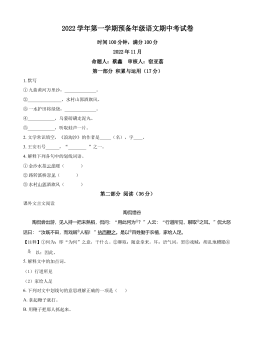
 2024-09-24 9
2024-09-24 9 -
上海市回民中学2022-2023学年(五四学制)六年级上学期期中语文试题(解析版)VIP免费

 2024-09-24 8
2024-09-24 8 -
上海市黄浦区2022-2023学年(五四学制)六年级上学期期中语文试题(原卷版)VIP免费

 2024-09-24 7
2024-09-24 7 -
上海市黄浦区2022-2023学年(五四学制)六年级上学期期中语文试题(解析版)VIP免费
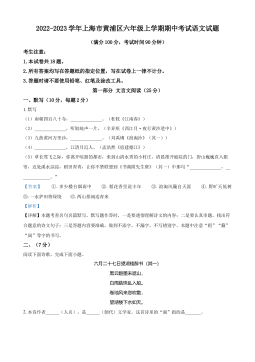
 2024-09-24 7
2024-09-24 7 -
上海市长宁区2020-2021学年六年级上学期期末语文试题(原卷版)VIP免费
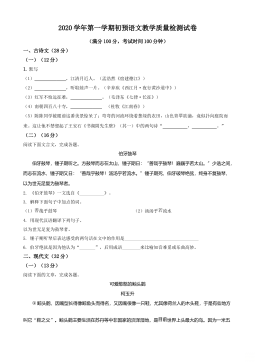
 2024-09-30 8
2024-09-30 8 -
上海市长宁区2020-2021学年六年级上学期期末语文试题(解析版)VIP免费
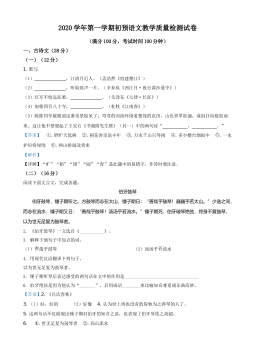
 2024-09-30 9
2024-09-30 9 -
上海市杨浦区2020-2021学年六年级上学期期末语文试题(原卷版)VIP免费
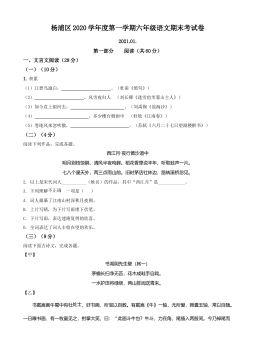
 2024-09-30 7
2024-09-30 7 -
上海市杨浦区2020-2021学年六年级上学期期末语文试题(解析版)VIP免费
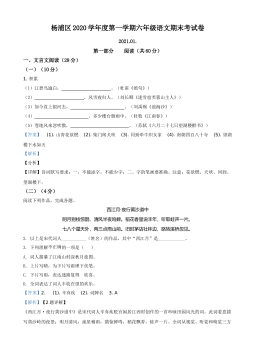
 2024-09-30 10
2024-09-30 10 -
上海市徐汇中学2020-2021学年六年级(五四学制)上学期12月月考语文试题(原卷版)VIP免费
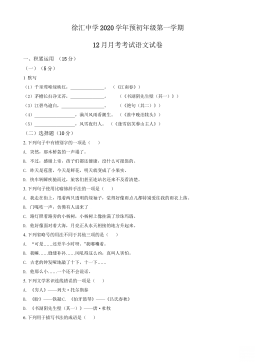
 2024-09-30 7
2024-09-30 7 -
上海市徐汇中学2020-2021学年六年级(五四学制)上学期12月月考语文试题(解析版)VIP免费
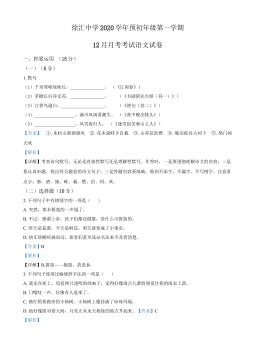
 2024-09-30 8
2024-09-30 8
作者:赵德峰
分类:高等教育资料
价格:15积分
属性:68 页
大小:3.08MB
格式:PDF
时间:2025-01-09
作者详情
相关内容
-
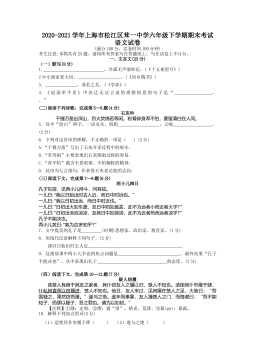
上海市松江区2020-2021学年六年级下学期期末考试语文试卷
分类:中小学教育资料
时间:2024-09-30
标签:无
格式:DOCX
价格:5 积分
-
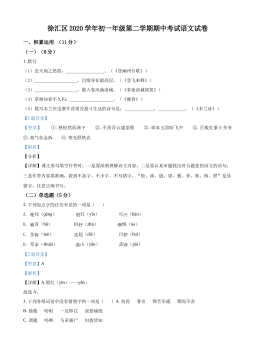
上海市徐汇区2019-2020学年六年级(五四学制)下学期期中语文试题(解析版)
分类:中小学教育资料
时间:2024-09-30
标签:无
格式:DOCX
价格:5 积分
-
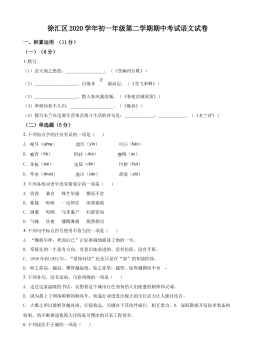
上海市徐汇区2019-2020学年六年级(五四学制)下学期期中语文试题(原卷版)
分类:中小学教育资料
时间:2024-09-30
标签:无
格式:DOCX
价格:5 积分
-
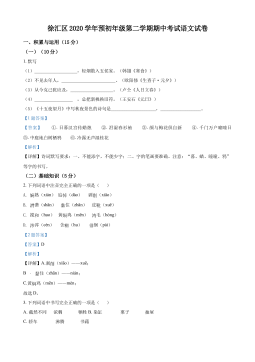
上海市徐汇区2020-2021学年(五四学制)六年级下学期期中语文试题(解析版)
分类:中小学教育资料
时间:2024-09-30
标签:无
格式:DOCX
价格:5 积分
-
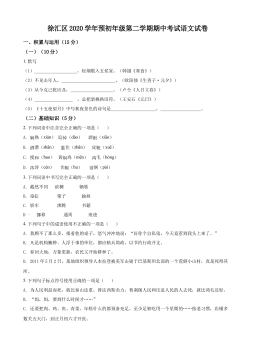
上海市徐汇区2020-2021学年(五四学制)六年级下学期期中语文试题(原卷版)
分类:中小学教育资料
时间:2024-09-30
标签:无
格式:DOCX
价格:5 积分






